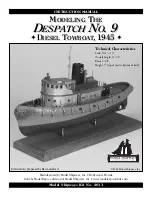
10
9. Bow Chock, Cleats, & Manholes
The bow chock casting is different from the
bulwark chocks as it has a bottom flange.
Glue it on the rail forward as shown on the
plan. The manhole castings require holes to
be drilled in the deck. There are three deck
cleat castings. One forward and one port and
starboard near the bulwarks in way of the
bulwark chocks.
10. Capstan & Towing Machine
Both are Britannia castings. The towing
machine is supplied in six Britannia parts.
Assemble before installation. A drawing of the
machine and assembly instructions are shown
on Plan Sheet 1, and Figure D-4 is a pictorial
view. For the platform, cut from basswood,
3/16" thick.
The Capstan is a single casting. Install at the
location shown on plan.
11. Air Vents
There are two identical castings. Drill holes
in the hull deck just forward of the deck-
house and insert the vents. Notice at the
top, the vent barrels at the end of the goose-
neck should be facing outboard, opposite of
each other.
12. Log Fenders & Bow Bumper
Make the log fenders from wood dowels and
wrap the area shown on the plan with black
sewing thread. Paint the dowel a light tan or
brown color. Drill a hole in the top of each
fender for an attachment line. How the lines
are attached to the hull is unknown. You
could put an eyebolt in top of the rail at each
fender or just glue the line on the inside of the
bulwark (Figure D-5). Rubber tires were also
used often on tugs instead of these log fend-
ers. So you have an option.
Now the Bow Bumper is something left to
your creative mind. Various types of cheese
cloth, wash rags, pieces of real rope cut up
and glued together, and the like are just some
thoughts. Whatever you come up with, secure
it to eyebolts at the rail as shown on the plan.
13. Anchor
The
Despatch
model plans do not show an
anchor or any means for handling an anchor.
It’s possible no anchor was ever carried since
the boat was used mostly for towing. Howev-
er, an anchor has been provided in the kit as a
free gift. The original Army tug design has an
anchor and a small davit at the bow for han-
dling the anchor. There is a socket in the deck
port and starboard so the davit can be used on
either side. The
Despatch
has several configu-
ration details different from the original
design, probably to accommodate the owners
desires when built. Since the original Model
Shipways plans had no davit, it was probably
not fitted. Another puzzle in the world of
shipbuilding.
14. Final Touches
If you have not done so, install
the deckhouse on the hull. Again,
watch out for glue squeeze-out.
You may need to add some wood
filler at the house-deck joint.
Touch up paint after the filler
is sanded.
Finally, check to see if any of
the painted wooden or metal
parts were marred or scratched
during construction and
touch-up as necessary.
Congratulations—you’ve done
it! We look forward to helping
you with your next ship
modeling project.
FIG. D-3 STERN GRATING
FRONT SUPPORT
BEAM
STRIP
AROUND EDGE
LASER-CUT
GRATING STRIPS
FIG. D-4 TOWING WINCH
FAIRLEADER
CASTING
WINCH DRUM
CASTING
BITTS CASTING
WOOD BASE
3/16" THICK
BRAKING DEVICE
CASTING
MOTOR & GEARS CASTING
FRAME CASTING
MOTOR UNDER
SHAFT
FIG. D-5
LOG FENDERS
WRAP WITH
THREAD
DOWEL






























